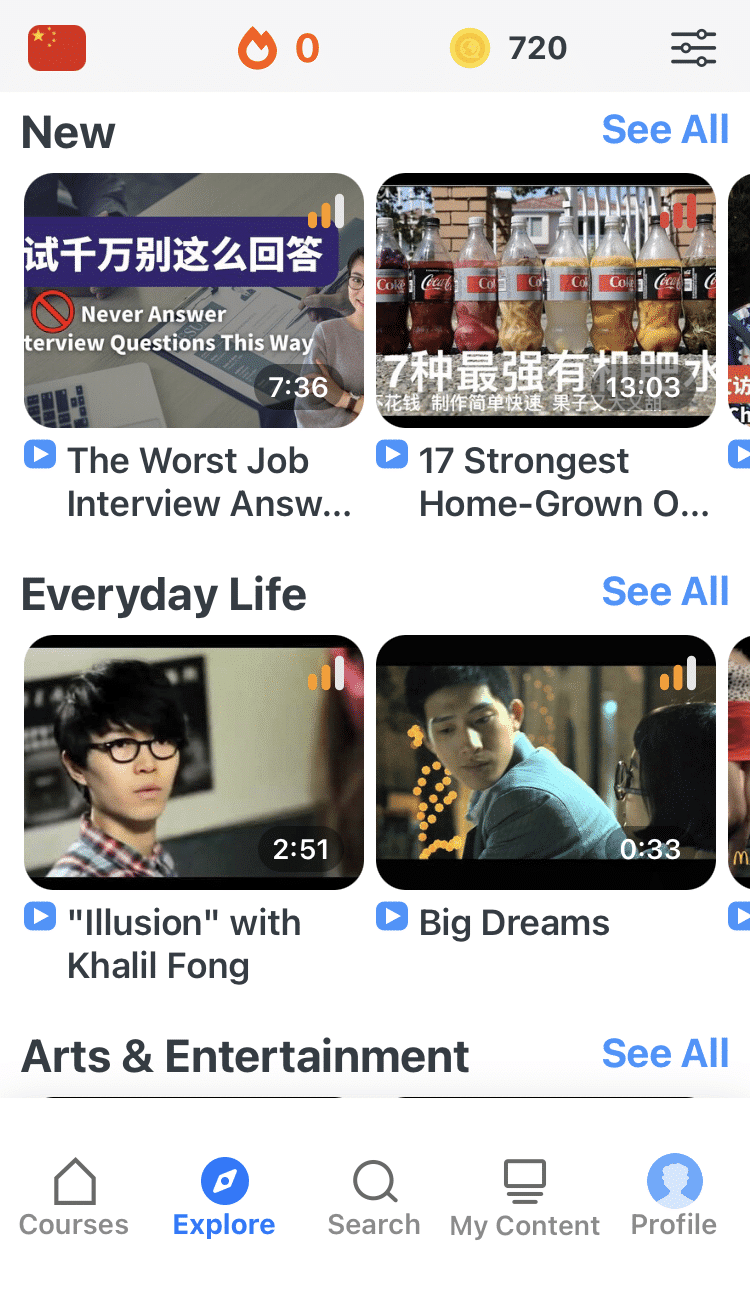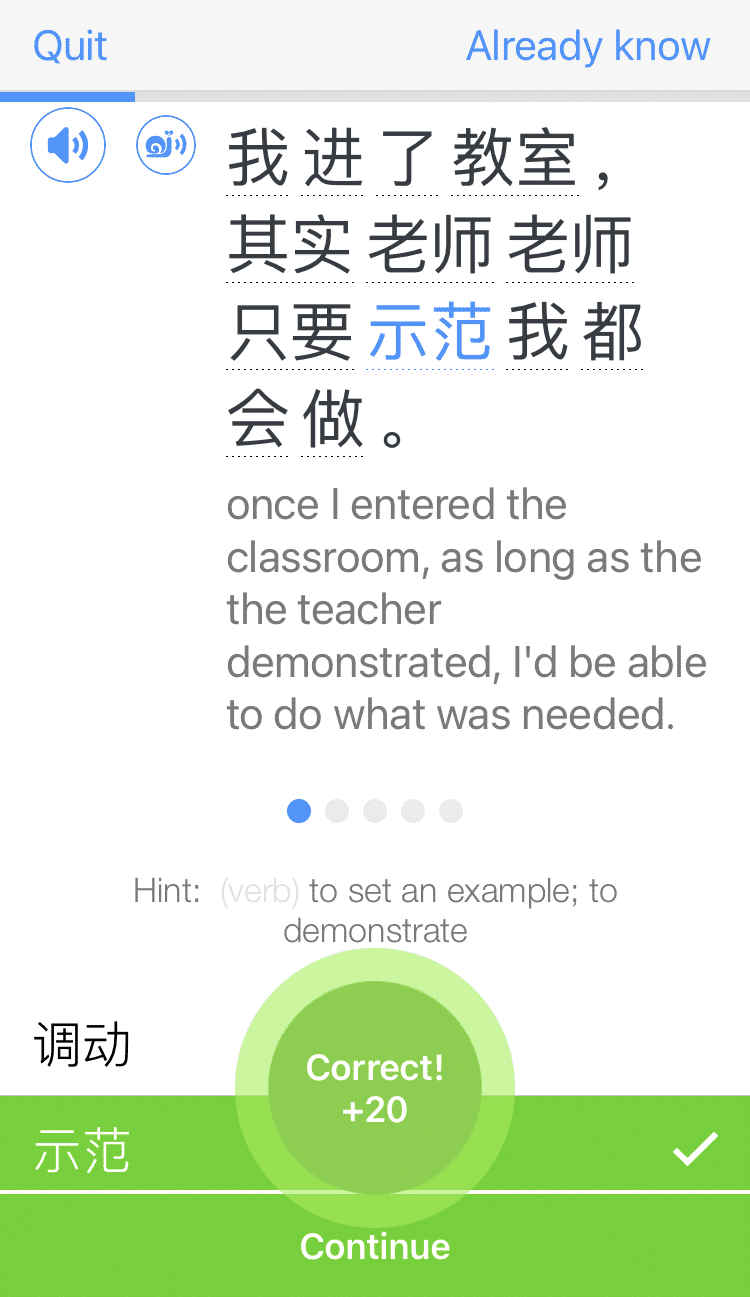
How to Speak Chinese Fluently: Top Tips for Learners of Any Level
Chinese people can’t tell that I’m not Chinese.
I don’t have a natural talent for languages. I was an average student who, in first-term classes, struggled with pinyin and tones along with everyone else.
What I do have is a disciplined approach that works. And I’m confident that anyone who applies it can also learn how to speak Chinese fluently.
I created my approach following two Chinese language learning summer programs: Duke Study in China and Princeton in Beijing (PiB).
They were not easy programs, but Duke and PiB gave me the foundation I needed to become a confident, fluent Mandarin speaker.
And today, I’m going to tell you exactly how to speak Chinese fluently using the same methods that got me to where I am today.
Contents
- 1. Cultivate the right mindset
- 2. Understand pinyin and tones
- 3. Gather the right learning materials
- 4. Immerse yourself in the language and culture
- 5. Speak Chinese as often as possible
- 6. Prepare for any conversation topic
- 7. Target your mistakes from the beginning
- 8. Learn filler phrases
- 9. Give yourself credit
- Learn How to Speak Chinese with FluentU
- And One More Thing...
Download: This blog post is available as a convenient and portable PDF that you can take anywhere. Click here to get a copy. (Download)
1. Cultivate the right mindset
This is the foundation for all of your Chinese learning.
Learning any language requires a ton of discipline because it’s uncomfortable. It’s not what you’re used to doing. You’ll need to spend a lot of time focusing on what you’re not good at while dealing with delayed gratification.
The best way to address these challenges is to make sure you have the right mindset about learning to speak Chinese. You’ll want to:
- Know that making mistakes is natural. Especially when you start out, the language will just be an arbitrary collection of sounds and images to you. Making mistakes is how you begin to make sense of it all.
- Change the way you measure progress. Instead of seeing perfection as a good thing, flip the equation and see mistakes as progress. If you stop making mistakes, then you’re no longer improving!
- Understand that speaking fluent Chinese is just a matter of time. Just as friction makes a rough rock smooth over time, learning to speak Chinese well requires a similar process of identifying rough edges and smoothing them out.
Not convinced?
This post from the popular Fluent in 3 Months blog discusses how perfectionism is a terrible attribute for language learners. This post at Hacking Chinese provides some great, specific tactics that can help you be more receptive to feedback. And this post on the FluentU blog explains why Mandarin is actually not as difficult as many people think it is.
2. Understand pinyin and tones
Even if you never want to learn to read or write Chinese characters themselves, you’ll need to know pinyin, the Romanized version of the Chinese language.
Pinyin is how you will learn the sounds and pronunciations of Mandarin using the Latin letters you already know so well.
Then, you’ll need to get a grasp on tones. They’re essential for learning how to speak Chinese. I mean, check out these variations of ma—you can click on the characters to hear how the tones change the sound of each word:
All of these words are said with slight tonal differences and all mean vastly different things. You definitely don’t want to accidentally call your mother a horse, so you’ll need to understand how tones work and how important they are.
English speakers are used to having words that sound phonetically very different. Mandarin has no such luxury. Tones are the key to speaking comprehensible Chinese.
It’s tricky to get the hang of at first if you speak English or any other non-tonal language, but, as always, practice makes perfect.
3. Gather the right learning materials
Learning how to speak a language is different from learning how to read and write a language—particularly for one like Mandarin. The materials you need to learn 汉字 (hàn zì), or Chinese characters, will differ from the materials you need to learn to speak and listen in Chinese.
To improve your Mandarin speech, you really only need a plain ol’ notebook and access to Chinese video or audio content.
When I first started learning the language, I used two separate notebooks for practice. One was for practicing pinyin with the respective hanzi, and the other was for pinyin-only sentence building, so I could practice my speech.
You can do the same. Fill this second notebook with phrases commonly used in everyday life, as well as phrases that you personally use often.
A great way to pick up a lot of new phrases is by watching videos! A favorite listening resource of mine is Chinese-language TV shows.
For example, I was able to get the hang of tones and the speed of Mandarin speech by watching the Taiwanese TV drama “惡魔在身邊” (è mó zài shēn biān) — “Devil Beside You.” And by “watch,” I mean I binged the whole thing in a week!
Though entertaining and the result of having no self-control, that week was actually incredibly educational. Speaking Mandarin stops being theory and becomes real when you listen to others speak it.
When using videos to learn speaking skills, you can practice language shadowing. This is when you try to mimic what the person on screen says as accurately as possible—and it can be super helpful for making your Chinese speech sound more fluent. You can read more about the practice of shadowing here.
So, to recap, the “right materials” really just means a notebook and some good audio content that you enjoy listening to.
4. Immerse yourself in the language and culture
In both of my programs at Duke and PiB, students were required to sign an oath on the first day of class. You swear that you won’t speak any English during the program, each of which is two months long.
Of course, not everyone respects the oath 100%.
But I really wanted to make the best use of my time in China, so I fully upheld my oath. I never spoke English to anyone in the program. I never spoke English to anyone on the phone (I could catch up with my friends later). I even stayed away from reading or hearing any English news!
I didn’t even give in when our class went to karaoke and everyone started singing Backstreet Boys songs. I stuck with the oath: Only speak in Chinese.
So it was basically total immersion. All input that my brain received was in Chinese.
This not only allowed me to gain a deeper understanding of the language itself, but also of the culture. Language and culture are pretty intrinsically linked, and in pretty much every case, learning more about one allowed me to discover more about the other at the same time.
And if you know anything about the benefits of immersive learning, that meant that all of my Mandarin skills—including speaking—improved by leaps and bounds.
5. Speak Chinese as often as possible
When you’re in class or hanging with your Chinese friends, you have to try to talk a lot. It’s a crucial practice for learning how to speak Chinese fluently.
There are two invaluable functions of speaking the language as much as you can:
- Speaking a lot strengthens your knowledge of tricky words and phrases.
- Making mistakes when you speak exposes your weaknesses so you can improve them.
There is a corollary that arises out of these two points: Don’t waste time on vocabulary and phrases that you already know.
Go out of your way to talk using Chinese words that you don’t know well and you don’t feel comfortable with. That way, you can learn how they work with the contextual knowledge you need to cement them in your brain.
And, if you don’t have enough people around to speak Mandarin with, talk to yourself!
Try this simple exercise for the day: Start speaking Chinese in your head the moment you wake up. Actively force your brain to translate everything you’re thinking into Chinese. Even the simplest things (like, 我起床了 (wǒ qǐ chuáng le) — I got up) will help you process the language.
After teaching yourself to think in Chinese, start narrating your day out loud. Yes, do it! You may not usually say “I got out of bed” in English, but remember—you’re learning a new language just as a child would.
As you go about your daily activities, narrate what you’re doing and thinking about out loud in Mandarin. Talk to your pets. While listening to the news or the radio, respond to the commentators. Doing a chore? Talk about it!
And once you’re comfortable speaking to yourself, why not find a language partner?
6. Prepare for any conversation topic
If you’re planning to speak a lot, especially to other people, you’ll need to be prepared for the topics you might be speaking about.
That doesn’t mean you need to know every possible vocab word that might come up, however. In fact, a major requirement for fluency in a language is being able to navigate around obstacles you find in your path.
If you get stuck on every single word you want to say, you won’t sound very fluent. But, if you can talk around these words, the listener might not notice that you didn’t know it. They may even instinctually fill in the missing word for you.
Practice this by describing words in Chinese without actually saying them! This will prepare you for an emergency vocabulary situation. You can read more about how to practice this here.
Sometimes, you can control the flow of conversation and stick to things you have the words for. To really be able to speak comfortably in any situation, though, you’ll still need a breadth of vocabulary.
Again, fluency is about being able to talk about all kinds of topics with relative ease. To achieve this, you will need to practice speaking about different topics and learning at least the main vocabulary terms required to discuss them.
Over the course of the day, you can jot down different topics in a notebook or on flashcards. Work on digging up topics that you know little to nothing about in Mandarin.
Pick a new topic to cover daily or weekly and then gear your language study towards that topic. Native speakers have had a lifetime to practice, sure, but you can cover a lot of ground by staring now and reviewing daily.
7. Target your mistakes from the beginning
Talking a lot means you’re going to be making a lot of mistakes. (This is a good thing, remember?)
However, just making the mistakes is not enough to help you improve your Chinese speaking abilities.
What you really need is someone to provide critical feedback about your mistakes—immediately, if possible. Ideally, that feedback would come from an eager, tireless, supportive Chinese teacher who is at your side every waking moment and vigilantly points out your every mistake.
You can have the next best thing by finding a tutor online. For example, Verbling is one of the most highly recommended places for finding the perfect language teacher for your needs. You can filter through hundreds of language teachers and find the tutor who’s right for you.
When you search, you can do so by price, availability and even the other languages they speak—so if your native language is Spanish or German, you can find a Chinese teacher to teach you in that language. Plus, Verbling’s technology makes accessing tutoring sessions extra smooth since you can access them right through the site.
You can of course target mistakes on your own, too, with the help of learning resources and programs.
It’s important to note, however, that there are different kinds of mistakes, and not all tools are created equal in providing feedback for each of them. Here are just a few common mistakes made by language learners:
- Recall: Sometimes you just have trouble remembering a word. In this case, most flashcard programs are sufficient for helping you correct these mistakes.
- Grammar, diction and word choice: You can use authentic Mandarin resources like movies, TV and podcasts to watch and listen to native Chinese speakers use the language. This is an excellent way to hone your word choice and usage, improve your diction and get a better grip on grammar.
- Pronunciation: This can be tricky to correct. Again, a tutor or language partner would be ideal, but if that’s not an option for you, many sites have speech recognition technology which claims to provide feedback on pronunciation issues.
Each time you identify these kinds of mistakes, you’ll have to make sure that you know what the right answer is in each instance. You’ll also have to make sure that you revisit them at the right time.
For me personally, pronunciation was the hardest part. Especially because if I tried to ask someone who wasn’t a teacher, I had to ask over and over again: “What am I saying wrong?” The first four times, they’d say, “Nothing!” And then finally, on the fifth time, they’d say, “OK, if you really want to know…”
If this happens to you, you can review our full Chinese pronunciation guide, try practicing with some tongue twisters or hone in on Chinese vowels (which tend to be a big sticking point).
8. Learn filler phrases
It is possible to fake fluency if you really want to, especially if you have some control over the choice of topic, as we went over above. Simply learn a few phrases to turn the topic into one where you have something interesting to say, then follow up with an anecdote.
For example, if you’re learning Chinese for professional purposes, focus on key Chinese phrases related to business. If you’re fascinated by Chinese culture, learn how to talk about the Mid-Autumn Festival, Dragon Boat Festival or Qingming Tomb Sweeping Festival.
This method means you’ll need to take control of the conversation and steer it to a topic you’re familiar with.
This isn’t always easy, of course. Sometimes, we don’t think as quickly as we speak, which tends to trip us up.
Fortunately, there are many phrases that carry almost no meaning but simply exist to buy you time to think. We do this in English all the time (“I mean,” “like,” “you know,” etc.), and Mandarin speakers aren’t any different.
So when you listen to native Chinese speakers, take note and learn the phrases they use in this way. You’ll hear the equivalents of sayings like, “What you said is very interesting, but…” or “I think that depends on…”
Even shorter phrases (“I think,” “in my opinion”) can give you a few extra seconds to compose your thoughts in Mandarin.
The point is that when you know several dozen phrases like this and can use them fluently, you’ll get a chance to remove some pauses from your speech while still having a moment to figure out how you want to respond.
Instead of falling silent for five seconds or letting out a long “ummmm,” you’ll fill that pause with solid Chinese.
9. Give yourself credit
If you’re going to walk away from this post with only one thing, let it be this: Your Mandarin might never be perfect, but that doesn’t mean you should give up.
If you’re an adult learning a second language, even if you immerse yourself in that language for years, you might still have an accent or you might say particular things in a way that makes it clear you’re not a native speaker.
For example, native Mandarin speakers (as well as Japanese) cannot easily distinguish between “r” and “l” sounds in English because they’re phonemes that are incredibly difficult to change in the mature brain. Similarly, native English speakers can’t always learn foreign phonemes easily either.
Learning how to speak Chinese is going to constantly surprise you, at every level. Even if you master sentence structure, word order and tones, you’ll still encounter phrases in Mandarin that don’t make a lick of sense.
And that’s ok!
Mandarin Chinese is statistically one of the hardest languages (for native English speakers, particularly)—if not the most difficult of them all.
It’s important to forgive yourself if you run into roadblocks—learning any language has its difficult moments!
Learn How to Speak Chinese with FluentU
FluentU is a language learning program and app designed to help you learn Chinese through videos.
You can see and hear the language as it’s used naturally in clips made by and for native Mandarin speakers. Videos include movie scenes, news segments, inspirational talks, vlogs and more, all combined with learning tools to help you follow along.
For instance, you can read along with traditional or simplified Chinese subtitles, and toggle pinyin and English subtitles on or off depending on your learning needs and what you’re trying to practice—listening comprehension, speech shadowing or something else.

Even with the English subs off, you won’t get lost—FluentU videos use interactive subtitles. These let you hover over or click on any word for a definition.
Clicking on a term also allows you to view a full flashcard, complete with example sentences, audio and additional videos the word appears in. You can then add the word to your own customizable flashcard decks for study.
When you’re ready to practice, you can review words you’ve saved via FluentU’s personalized quizzes.
Quizzes adapt to your learning level and progress, and they utilize spaced-repetition software—meaning that FluentU can let you know the optimal time to review each of your flashcard decks. Quizzes also include speaking questions to help you learn how to speak Chinese more fluently.
The FluentU program is available right in your browser, or you can download the app (iOS or Android) and study wherever you are, whenever you’d like.
Those are my best tips for learning to speak Mandarin fluently!
There’s no time like the present, so put these to practice today and I bet you’ll see results before you know it.
Download: This blog post is available as a convenient and portable PDF that you can take anywhere. Click here to get a copy. (Download)
And One More Thing...
If you want to continue learning Chinese with interactive and authentic Chinese content, then you'll love FluentU.
FluentU naturally eases you into learning Chinese language. Native Chinese content comes within reach, and you'll learn Chinese as it's spoken in real life.
FluentU has a wide range of contemporary videos—like dramas, TV shows, commercials and music videos.
FluentU brings these native Chinese videos within reach via interactive captions. You can tap on any word to instantly look it up. All words have carefully written definitions and examples that will help you understand how a word is used. Tap to add words you'd like to review to a vocab list.
FluentU's Learn Mode turns every video into a language learning lesson. You can always swipe left or right to see more examples for the word you're learning.
The best part is that FluentU always keeps track of your vocabulary. It customizes quizzes to focus on areas that need attention and reminds you when it’s time to review what you’ve learned. You have a 100% personalized experience.
Start using the FluentU website on your computer or tablet or, better yet, download the FluentU app from the iTunes or Google Play store. Click here to take advantage of our current sale! (Expires at the end of this month.)






